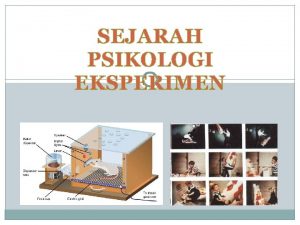TwoFactor Designs EXPERIMENTAL PSYCHOLOGY GUIDEDINQUIRY LEARNING Module TwoFactor
















- Slides: 16

Two-Factor Designs EXPERIMENTAL PSYCHOLOGY GUIDED-INQUIRY LEARNING Module: Two-Factor Designs © 2019, Dr. B. Rumain & Dr. A. Geliebter, Touro College & University System

MOTIVATION When you do research, sometimes you feel that it is more than one variable that is affecting outcomes. For example, in studying depression, you may feel that medication is important but that exercise is also important. In such cases, you would have what is called a two-factorial design, where you are looking at the two factors: (1) medication; (2) exercise; as to how they influence recovery from depression.

LEARNING OBJECTIVES • You will learn what a 2 -factorial design is. • You will be able to design an experiment where 2 factors are involved. • You will be able to interpret individual effects (main effects) and joint effects (interaction effects) in 2 -factorial designs.

INFORMATION Suppose you are interested in how to help people with depression. Suppose you hypothesize that one factor to alleviate depression is medication, our new drug Elate, and you want to know whether it will reduce the symptoms of depression. You also feel that a second factor to alleviate depression is walking at least 30 minutes in the fresh air. In this case, you have what is called a 2 factorial design. The 2 factors are just the 2 independent variables.

List the two independent variables: Independent variable #1 is ________ Independent variable #2 is ________ List 2 possible levels of each independent variable: The 2 levels of independent variable #1 are: _____, _______ The 2 levels of independent variable #2 are: _______, ________

Let’s say you gave the following answers: List the two independent variables: Independent variable #1 is dosage of medication Independent variable #2 is walking _ List 2 possible levels of each independent variable: The 2 levels of independent variable #1 are: 0 mg , 750 mg. The 2 levels of independent variable #2 are: Yes walk , No walk. For each independent variable, what is the control group?

For each independent variable, what is the control group? Independent variable #1’s control group: 0 mg. Independent variable #2’s control group: No walk. Remember, the “ 0 mg. Group” would get a sugar-coated pill, a placebo, so that they think they are getting the treatment as well.

As we can see, the subjects that do not get the treatment are the control group. The ones that do get the treatment (the “ 750 mg dosage” condition, the “yes walk” condition) are the experimental groups for that independent variable. So, we have two levels of dosage (0 mg and 750 mg), and two levels of walking (Yes walk, No walk). List all the possible combinations of dosage with walking.

These are the 4 possible combinations: (1) 0 mg. , yes walking (2) 0 mg. , no walking (3) 750 mg. , yes walking (4) 750 mg. , no walking We can arrange them in a Latin square, as follows: Dosage = Independent Variable #1 Walking = Independent Variable #2 0 mg. 750 mg. Yes walk 0 mg. Yes walk 750 mg. Yes walk No walk 0 mg. No walk 750 mg. No walk

Dosage = Independent Variable #1 Walking = Independent Variable #2 0 mg. 750 mg. Yes walk 0 mg. Yes walk 750 mg. Yes walk No walk 0 mg. No walk 750 mg. No walk Now list all possible separate and joint effects: ___________________________________

These are the separate and joint effects: Separate Effects (1) Only the medication matters. Those that get the treatment, the medication, do significantly better in terms of symptom relief from depression, than those who don’t, the 0 mg. group, regardless of whether they walk or not. This is called a main effect. We would say “there is a main effect of dosage. ” (2) Only the walking matters. Those that get the intervention of walking do significantly better than those who don’t walk, regardless of the dosage of medication. So, the medication doesn’t help; only the walking helps. In this case, we would say “there is a main effect of walking. ” Now, what are the possible joint effects?

Joint effects: There is a joint effect when the 2 independent variables interact. Let’s say if a depressed individual doesn’t walk, then he needs medication to get symptom relief from depression. BUT, if someone does walk, then he doesn’t need the medication to get the same symptom relief.

In this case, you’d say dosage interacts with walking or you could also say that there is an interaction between the two independent variables in terms of providing symptom relief from depression. The advantage of a factorial design over a single factor design is that it permits us to examine both the individual effect (main effect) and joint effect (interaction) of two or more independent variables.

Another scenario of an interaction might be as follows: If a person takes a medication, it doesn’t matter if he walks or not. But if he doesn’t take the medication, then if he walks, he gets symptom relief from depression (i. e. feels less depressed). But if he doesn’t walk, then he doesn’t feel less depressed. How would you use a bar graph to illustrate this scenario? Amount of Symptom Relief from Depression Yes Walk No Walk Yes Meds No Meds

Amount of Symptom Relief from Depression Yes Walk No Walk Yes Meds No Meds

The advantage of a factorial design over a single factor design is that it permits us to examine both the individual effect (main effect) and joint effect (interaction) of two or more independent variables.
 Twofactor authentication
Twofactor authentication Basic principles of experimental design
Basic principles of experimental design Randomized block design vs matched pairs
Randomized block design vs matched pairs Design research meaning
Design research meaning Basic principles of experimental design
Basic principles of experimental design Quasi-experimental research designs
Quasi-experimental research designs Quasi-experimental research designs
Quasi-experimental research designs Experimental vs non experimental
Experimental vs non experimental Descriptive studies
Descriptive studies Experimental vs non experimental research
Experimental vs non experimental research Experimental vs nonexperimental
Experimental vs nonexperimental Experimental vs non experimental
Experimental vs non experimental Proposal penelitian eksperimen psikologi
Proposal penelitian eksperimen psikologi Sejarah psikologi eksperimen pdf
Sejarah psikologi eksperimen pdf Experimental method in psychology
Experimental method in psychology Merits and demerits of introspection method in psychology
Merits and demerits of introspection method in psychology Alla chavarga
Alla chavarga































